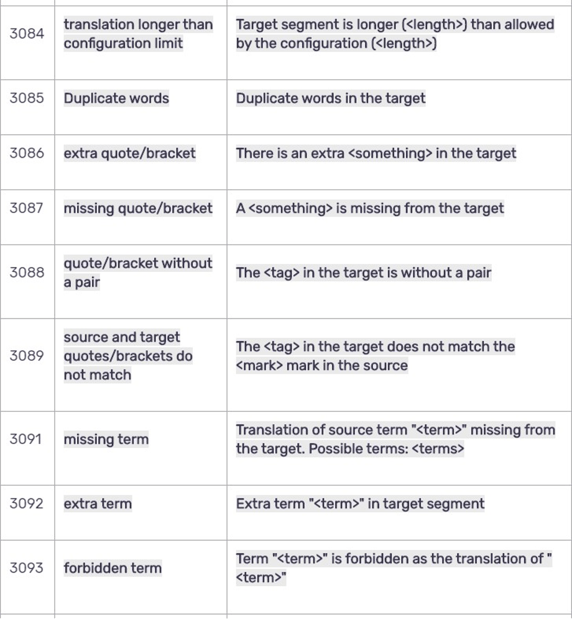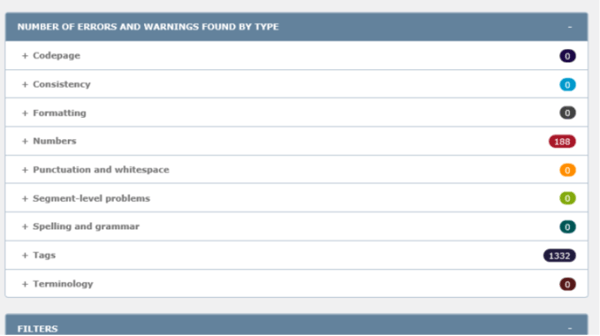.png?width=740&name=vector%20concept%20of%20translation%20quality%20assurance%20(1).png) How do you know if translations delivered by your localization company are ready to be published?
How do you know if translations delivered by your localization company are ready to be published?
After all, you do not speak all the languages that your content has been translated into. So, how do translation companies make sure that the delivered translations are correct?
ATL has been securing the success of leading global businesses on local markets for 15 years. It's a mixture of talent and hard work that helps us succeed and provide top quality translations on time, per specification and on budget.
If you are interested in how translation companies make sure that translations are correct, this article is for you. To make sure that your translations are in good hands, check to see if your translation agency follows at least the basic steps mentioned in this article.
Gaining experience through 15 years of managing multilingual projects has helped us develop excellent quality assurance solutions. A deep understanding of linguistic nuances enriched with the flexibility acquired through working on various projects and being powered by the latest technology is what helps us provide effective translation quality assurance.
All the while, we maintain ISO 17100:2015 standards for translation services. That is how we roll.
.png?width=496&name=image%20symbolizing%20business%20partnership%20i.e%20with%20a%20translation%20company%20(1).png)
One of the basic steps to ensuring the highest quality of translated text is choosing the right person for the translation job.
Just like you screen translation companies before assigning your content for translation, translation companies screen linguists. The linguists often perform test translations before being assigned the full project.
These are short translations on various topics, which are then evaluated by trusted revisors. The translators are scored and provided with feedback. The feedback and score are archived in the translation company's database, usually a professional TMS (Translation Management System). It helps project managers assign linguists that are the most suitable for your content.
When it comes to starting a collaboration with professional translators, there are some rules to follow.
Rule number one is that the translator needs to be a native speaker of the language for translation.
So, if you want to translate your documentation into Japanese, the translator needs to be a native Japanese speaker and also needs to be a professional translator. That needs to be proven by a university degree or over 5 years of documented experience as a translator.
-2.png?width=600&name=translation%20technology%20(1)-2.png)
Rule number two is to know how to use professional translation software. CAT (Computer-Assisted Translation) tools, in order to be able to provide translations in a cost-effective way and use the full spectrum of native QA functionality, should be manually fine-tuned according to the needs of a given language pair.
Translations powered by translation software do not mean translations provided by machines. It only means that their technology helps translation companies prepare files for translators in a way that they can work more efficiently by reusing repeating parts of the content. This can significantly influence translation costs.
Related content: How to Really Save on Translation and Localization
Proper use of translation technology can generate cost reduction. Moreover, the use of CAT tools can significantly boost translation quality with automated QA checks. Actually, the better the technology, the more easily quality assurance is provided and the better the final translation.
The translator should be an expert in the subject matter. May it be medical equipment, pro-audio tools or software, natural oils or mining, the translator needs to understand the subject matter.
This can be verified by examining the linguist's documentation but also by verifying translation samples.
Every text translated by a professional linguist is proofread after translation. Professional translators claim that it’s best not to do it immediately after typing the last sentence, but to wait a while.
This verification allows translators to make sure that the translation reads well and that the translated segments are correct not only as a separate sentences, but also as a whole.
.png?width=554&name=businessmen%20discussing%20partnership%20i.e%20translation%20(1).png)
The translation step is most often followed by a bilingual examination, meaning comparing the original with the translation and a general examination of the text. The step following translation is called Revision.
Another pair of eyes revises your content after its translation. This step is added to the process in order to check if everything was translated correctly and ensure that the translation is free from any potential errors, both in terms of quality and language. Sometimes, the revisor finds parts of the text that need to be amended.
Related content: 5 Ways That Translation Revisors Affect Your Business Growth
Possible issues may be omissions or mistranslations, inconsistency (on terms, segments or sentences), or a typo that an automated spellchecker did not catch.
For example, the words "marital" and "martial" are both correct when it comes to spelling but they are used differently in different sentences (called an atomic typo; a typo that creates a properly spelled word but changes the meaning).
Although I suppose that there are people who have already used both of them in the same context, right? But definitely not in business communication. But getting back to spelling checks, such nuances are more easily spotted by a second pair of eyes checking the translated text.
When a translator checks their own text right after translation, there is a risk of overlooking errors. Allowing a significant amount of time between the translation and verification by the same linguist is advised.
If the revised text contains changes, the changes are acknowledged by the translator. There are times when the translator and revisor discuss some linguistic or grammatical nuances. Sometimes, a query needs to be sent to the client for more context.
.png?width=533&name=translation%20project%20manager%20checking%20content%20(1).png)
This step is one of the final steps after the translation process, before the text is handed back to you.
Verification includes checking if all the files or documents assigned are collected after translation and revision. The translation is again checked for any possible faults by running spellcheck and automatic QA checks again.
Related content: 7 Things Your Translation Project Manager Handles for You So You Don’t Have To
In case there were any questions asked by the linguists, at this point, the translation project manager checks if all the questions have been resolved and the translation team confirms having acknowledged and implemented the necessary changes.
Related content: The Critical Role That Reference Materials Play in Translation Quality
Also, adherence to provided reference material is verified together with going through special instructions once again and filling in an individual project checklist.
The verification step is the final check and often the final step in the translation process.
.png?width=654&name=translation%20software%20concept%20(1).png)
Translation software, called CAT tools (Computer Assisted Translation) is used on a daily basis by most of the translation companies and freelance translators.
These tools enable you to save money on translation and can significantly shorten project turnaround time. It is possible thanks to the core feature of translation software, which divides the content into smaller pieces (referred to as segments) and stores them with their translations in a database. The database is called the Translation Memory.
A translation memory is set for each project for a given language pair. For example, if you want to translate your content from English into Japanese, the translation company will create an EN-JP TM for you.
Another TM will be created if you decide to translate the same text into Spanish. The new TM will be for English-Spanish and will contain only the original English text and the Spanish translations.
Related content: Translation Memory Used in Practice [video]
Thanks to the fact that the translations are stored together with the original sentences, the CAT tools can scan any assigned documents and compare the original with what has been saved in the TM.
Should there be a match, the CAT tool will display relevant content to the translator to speed up the process, which maintains consistency and saves you money.
But the fact that all the translations stored in the TM are provided whenever they are needed to help the translator choose the right terms brings yet another advantage.
There is very little probability of introducing inconsistencies. Your audience will read about the same product feature or service with the same terminology and phrasing.
When talking about translation consistency, it is important to mention the solution that also helps making translations consistent. Integrating your system with translation software most certainly helps maintain consistency throughout the content while speeding it up.

If consistency is not maintained throughout the content concerning the product or service, this can be misleading to your clients. Imagine having the same product described in different terms on your website and completely different information put on an information brochure attached to the shipped product. Everybody takes consistency for granted. When it is overlooked, unpleasant things happen.
In order to keep the key terms of the translation in line with the voice of your brand, translation companies also use glossaries, term bases, or terminology lists. All of these names refer to the same thing. It is a collection of your individual key terms together with their translations, approved by you or your in- country reviewer.
Related content: 15 Myths About Style Guides and Glossaries for Translation
The glossaries are attached to CAT tools either as a separate integrated solution or (most often) using a built-in module. With the glossary attached to the translation project, the approved translation is suggested every time the piece of text the translation team is working on includes the key term.
A built-in separate module of CAT tools is the Quality Assurance module. There are more or less-advanced versions.
The basic issues that can be detected by such modules are covered by the below listed checks:
There are more things that can be verified by such modules, depending on the project or the CAT tool. Below you can see a table with some example of errors that can be reported by the CAT tool (memoQ) and their descriptions.

It may take anywhere from a few seconds to several minutes to check the whole content and generate the QA report.
When the report is ready, it is clear what kind of issues may require correcting. Sometimes the errors are not real issues and require human knowledge and understanding of the bigger context to decide if an error needs to be corrected or if it is just a false error notification.
For the sake of better visibility, in the case of memoQ, the errors listed on the QA report are marked in different colors:

QA modules can be more or less advanced. But these tools also allow a higher or lower level of customization for QA modules.
A professional translation software user can customize the QA modules in order to check the texts based on your requirements. This means that the automated checker can scan the translation and look for possible issues and then report the findings.
Related content: How to Measure the Quality of Translation
The person triggering the QA will be notified and must verify where the automated, customized check found something suspicious. What level of customization is possible?
Well, actually the sky is the limit. Or in other words, the time and the team's abilities to customize the modules are the only limit.
You do not have to know what the possible errors could be. That is the job of the localization engineer or QA specialist.
.png?width=559&name=concept%20of%20giving%20feedback%20i.e%20translation%20feedback%20(1).png)
Last but not least, the text is most often being reviewed on your side by your trusted in-country reviewer. It can be a local marketing team representative or in-country distributor.
Sharing feedback is important for your translation team to adjust to your reviewer's preferences.
Related content: 6 Powerful Ways to Improve Your In-country Review
Moreover, by sharing feedback you can choose the translation team that you prefer. This is one of the reasons for performing an in-country review on a translation sample before beginning a big project. It is a good place to start. You can work on the final quality together with the translation team by choosing what is right for you and your content.
What is even more important is to show the translation team any changes introduced. If the in-country review is done outside CAT tools, for example on the final text, even the smallest changes should be discussed with the linguists.
Related content: 6 Reasons Why Your Team May Fail at Translation Quality Review
Otherwise, even if the content was translated and revised by a professional linguist and the text went through the built-in and custom QA checks and verification, errors introduced by in-country reviewers can spoil the work of the whole team. This happens. It doesn’t happen intentionally, but good practice is to send the reviewed version back for finalization, at least in order to update the Translation Memory with your preferred wording or terminology.
.png?width=500&name=symbol%20of%20top%20quality%20i.e%20best%20translation%20quality%20(1).png)
Translation workflow based on ISO standards for translation services is a good starting point. It ensures consistent quality. Sourcing and testing translators and revisors before they even get invited to join the project team and providing them with feedback after the project has been delivered is how you develop your approved quality.
Using technology ensures not only savings and faster translation, but it also allows translation companies to boost quality. Developing custom QA settings for your projects allows faster quality checks, which means shorter deadlines.
Finishing the project with a verification step conducted by your dedicated project manager prevents undetected errors from getting through.
Last but not least, working with your feedback, implementing changes and finalizing the project allows the content to be in its best possible version.
If you want to know how your content can be protected from unwanted errors, contact us and we will find quality assurance solutions fine-tuned to your needs.
Recommended articles:
50+ Translation Integrations That You Should Know About
8 Translation Review Problems Making Your Translation Agency's Name a Cussword in Your Office
4 Aspects of Translation Agency's Size: Should It Matter to You?
+1 857 777 5741 ext. 203 (business inquiries)
+1 857 777 5741 ext. 205 (career inquiries)
Trylinskiego 16, 10-683
Olsztyn, Poland
Copyright ATL 2025. All Rights Reserved.